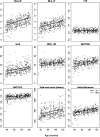Should We Stop Using Lexical Diversity Measures in Children's Language Sample Analysis?
- PMID: 38838249
- PMCID: PMC11253636
- DOI: 10.1044/2024_AJSLP-23-00457
Should We Stop Using Lexical Diversity Measures in Children's Language Sample Analysis?
Abstract
Purpose: Prior work has identified weaknesses in commonly used indices of lexical diversity in spoken language samples, such as type-token ratio (TTR) due to sample size and elicitation variation, we explored whether TTR and other diversity measures, such as number of different words/100 (NDW), vocabulary diversity (VocD), and the moving average TTR would be more sensitive to child age and clinical status (typically developing [TD] or developmental language disorder [DLD]) if samples were obtained from standardized prompts.
Method: We utilized archival data from the norming samples of the Test of Narrative Language and the Edmonton Narrative Norms Instrument. We examined lexical diversity and other linguistic properties of the samples, from a total of 1,048 children, ages 4-11 years; 798 of these were considered TD, whereas 250 were categorized as having a language learning disorder.
Results: TTR was the least sensitive to child age or diagnostic group, with good potential to misidentify children with DLD as TD and TD children as having DLD. Growth slopes of NDW were shallow and not very sensitive to diagnostic grouping. The strongest performing measure was VocD. Mean length of utterance, TNW, and verbs/utterance did show both good growth trajectories and ability to distinguish between clinical and typical samples.
Conclusions: This study, the largest and best controlled to date, re-affirms that TTR should not be used in clinical decision making with children. A second popular measure, NDW, is not measurably stronger in terms of its psychometric properties. Because the most sensitive measure of lexical diversity, VocD, is unlikely to gain popularity because of reliance on computer-assisted analysis, we suggest alternatives for the appraisal of children's expressive vocabulary skill.
Figures


Similar articles
-
Measurement of Lexical Diversity in Children's Spoken Language: Computational and Conceptual Considerations.Front Psychol. 2022 Jun 22;13:905789. doi: 10.3389/fpsyg.2022.905789. eCollection 2022. Front Psychol. 2022. PMID: 35814069 Free PMC article.
-
Relationship Between Children's Lexical Diversity in Written Narratives and Performance on a Standardized Reading Vocabulary Measure.Assess Eff Interv. 2019 Jun;44(3):173-183. doi: 10.1177/1534508417749872. Epub 2018 Jan 23. Assess Eff Interv. 2019. PMID: 34045929 Free PMC article.
-
Psychometric Evaluation of Lexical Diversity Indices in Spanish Narrative Samples From Children With and Without Developmental Language Disorder.J Speech Lang Hear Res. 2019 Jan 30;62(1):70-83. doi: 10.1044/2018_JSLHR-L-18-0110. J Speech Lang Hear Res. 2019. PMID: 30950757
-
Measuring lexical diversity in children who stutter: application of vocd.J Fluency Disord. 2002 Winter;27(4):289-303, quiz 303-4. doi: 10.1016/s0094-730x(02)00162-6. J Fluency Disord. 2002. PMID: 12506447
-
Word Learning in Bilingual Children at Risk for Developmental Language Disorder.Am J Speech Lang Pathol. 2024 Nov 4;33(6):2746-2766. doi: 10.1044/2024_AJSLP-23-00489. Epub 2024 Oct 7. Am J Speech Lang Pathol. 2024. PMID: 39374488 Free PMC article.
References
-
- American Speech-Language-Hearing Association. (2004). Preferred practice patterns for the profession of speech-language pathology [Preferred Practice Patterns]. https://www.asha.org/policy/pp2004-00191/ - PubMed
-
- Arkansas Department of Human Services. (2016). Provider manual update transmittal THERAPY-3-15. Retrieved March 2, 2024, from https://www.sos.arkansas.gov/uploads/rulesRegs/Arkansas%20Register/2016/... [PDF]
-
- Bawayan, R., & Brown, J. A. (2022). Language sample analysis consideration and use: A survey of school-based speech language pathologists. Clinical Archives of Communication Disorders, 7(1), 15–28. 10.21849/cacd.2022.00703 - DOI
MeSH terms
Grants and funding
LinkOut - more resources
Full Text Sources
Research Materials
Miscellaneous

